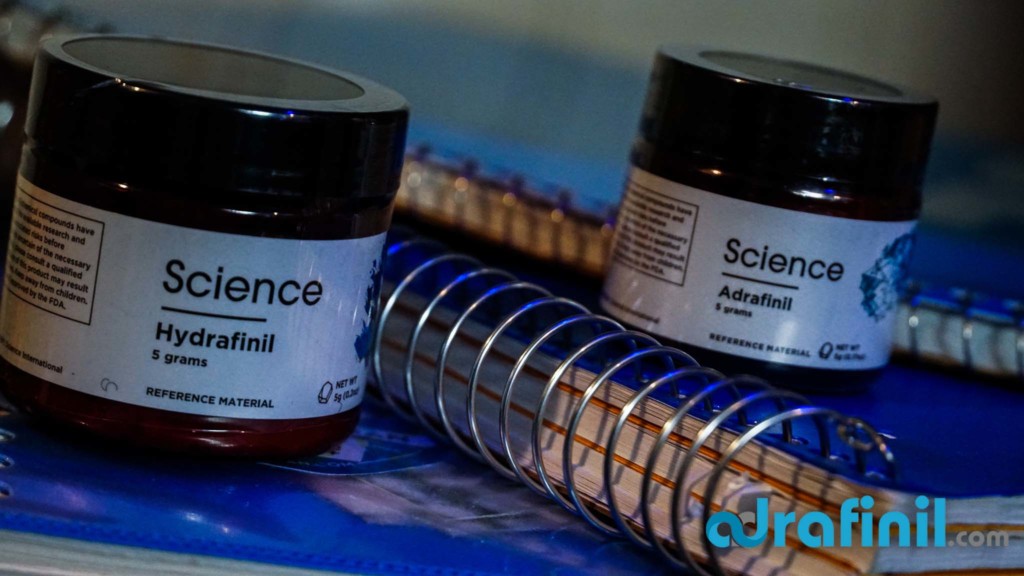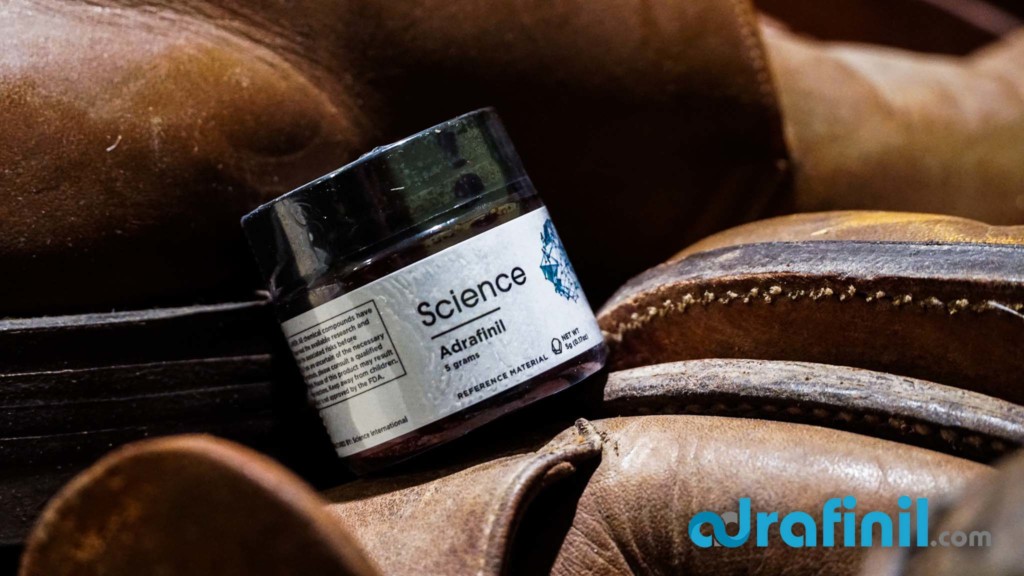Adrafinil is a central nervous system (CNS) stimulant that offers purported nootropic benefits including enhanced focus, improved mood, and cognitive-enhancing potential. But researchers who are new to vigilance-promoting compounds may be wondering, does adrafinil work?
This guide will offer a complete overview of adrafinil, including what it is, how it works, and a comprehensive list of its benefits and side effects. We will draw on data from clinical trials dating back to the 1970s, and explain what we know about this research chemical.
For researchers looking to run an adrafinil study, we will also offer our top recommendation for an adrafinil vendor who ships research-grade adrafinil worldwide.
Order Adrafinil online from the best vendor in the world!
Great prices, quick shipping, and guaranteed delivery.
Disclaimer: The contents of Adrafinil.com are for informational and educational purposes only. We do not provide legal advice. Likewise, we do not provide medical advice, diagnosis, or treatment. Please consult your physician prior to consuming Adrafinil or related nootropics. Your access to Adrafinil.com is subject to our full Disclaimer and Terms of Use.
What Is Adrafinil?
Adrafinil is classified as a “eugeroic,” which means it is a wakefulness-promoting agent [1]. It was first synthesized by French researchers working for Louis Lafon Laboratories in 1974 and released as “Olmifon” in 1985. Olmifon’s main use was to promote alertness and vigilance in elderly patients who suffered from daytime fatigue [1].
The French medical authorities withdrew marketing permission for Olmifon in the early 2000s and the drug, then manufactured by Cephalon France, ceased being produced in 2011. Since that time, several independent pharmaceutical companies continued producing generic adrafinil. In the United States, it is available as a research chemical.
How does adrafinil work?
Adrafinil’s exact mechanism of action is not yet fully understood, but much of adrafinil’s effect is believed to come from its active metabolite, modafinil. Adrafinil is a prodrug of modafinil—it is metabolized in the liver into modafinil and modafinil acid following ingestion [1].
Modafinil influences a number of neurochemicals involved in wakefulness and sleep cycles, including norepinephrine, orexin, histamine, GABA, and serotonin [2, 3]. Modafinil also upregulates dopamine [4], which may account for its positive effect on mood.
However, while both compounds are α1-adrenergic–receptor agonists and the bulk of adrafinil’s action may be attributable to modafinil, there are significant legal-regulatory differences between the two.
Modafinil is approved by the United States Food and Drug Administration (US FDA) to treat excessive sleepiness associated with a number of sleep disorders, while adrafinil’s run as a prescription medicine ended in 2011, following the French medical authorities’ conclusion that the drug had a high risk-to-benefit ratio.
So what do we know about adrafinil’s side effects and safety?

Adrafinil Side Effects and Safety
What about side effects—is Adrafinil safe?
As a caveat, there has been far less research conducted with adrafinil compared with modafinil, so we do not yet have a full picture of its safety profile. Furthermore, much of the research has focused on vigilance promotion and has involved elderly patients. Researchers should refrain from extrapolating adrafinil research findings to a wider population such as non-elderly patients.
To summarize what we know about adrafinil’s side effects and safety, there have been several clinical trials conducted with adrafinil—albeit small ones—and they have all supported the idea that adrafinil is safe and generally well-tolerated by most test subjects [1]. Adrafinil also does not appear to have any addictive qualities, and is not linked to any substances known to cause dependence.
The best data we have about adrafinil is an Olmifon product information summary published by Cephalon France in the French language. This document states that Olmifon could cause the following side effects when administered to elderly patients at a dose of 2-4 tablets daily (600-1,200 mg/d) [5]:
- Headaches
- Rashes
- Insomnia
- Mood swings
- Gastralgia
- Tremors
- Agitation, confusion, aggression, or “psychic excitement”
- Oral-facial dyskinesias
According to Cephalon France, these side effects are rarely encountered by patients and subside as soon as the dose of Olmifon is reduced or treatment ceases. Adrafinil has not been linked to any cases of overdose death [5].
While adrafinil is a liver-metabolized prodrug of modafinil that places some strain on the liver, there is no reliable long-term data showing what effect it has on liver enzyme values. As a precaution, Cephalon France’s insert states that patients with “severe renal impairment” should take a lower dose of adrafinil in the range of 300-600 mg/d [5]. The lack of data in this area shows that further research may be warranted.
We’ll now turn our attention to the question at hand, does adrafinil work?
Does Adrafinil Work?
So that brings us to the research—does adrafinil work and what are its effects?
Now, to be clear, there have been relatively few clinical trials on the effect of adrafinil in humans. Of those available, almost all have been conducted in France with elderly patients who have difficulty staying awake during the day.
This specific population means that it is difficult to know whether the findings can be generalized to other groups.
Still, the clinical trials conducted to date have been instructive, so we have summarized the primary studies below.
Dr. Israel and team
One research group, Israel et al., looked at the effect of adrafinil in elderly patients over 65 years of age who had problems staying alert [6]. The research team conducted a double-blind placebo study to see whether adrafinil would significantly improve vigilance in these patients. They also collected data on intellect, well-being, sleep, and other psychometric tests to assess cognitive function. There were 50 subjects in the adrafinil group and 49 in the placebo group.
The researchers gave participants three tablets of adrafinil, about 900 mg, per day for 90 days. They found that patients on adrafinil improved significantly compared to the control group. The improvements were seen at day 45 and persisted until the end of the study after 90 days.
In particular, the researchers noticed improved intellect, attention, concentration, power of recall, and vigilance. They noticed that adrafinil reduced forgetting, fatigue, and confusion. Participants in the adrafinil group also reported feeling happier and more energetic than the placebo group.
Dr. Kohler and team
Another team of researchers in France led by Kohler and Lubin looked at the effect of adrafinil in 304 individuals between the ages of 45 and 88 years of age [7]. Each of these individuals had known issues with attention and concentration, inactivity, sleep, memory, and anxiety. Each also had symptoms of depression.
Researchers gave participants in the treatment group 900 mg of adrafinil each day for 3 months—600 mg in the morning and 300 mg at noon. They compared the results to a placebo group. They collected data on a number of psychometric and affective scales that looked at vigilance, attention, concentration, perceptual-motor skills, depression, anxiety, and a scale that measured difficulty with daily life.
The researchers found significant improvements in a number of areas, including in vigilance, attention, and concentration. They saw participants’ scores on difficulty with their daily lives improve, which reflected improvements in memory. Adrafinil was also found to improve symptoms of depression and anxiety.
Dr. Dewailly and team
In a third study of 86 hospitalized individuals who had trouble staying awake and vigilant during the day, a group of researchers (Dewailly et al.) looked at the effect of adrafinil compared to a placebo over 60 days [10, cited in 1]. They had nurses observe patients in both groups and record their observations.
Nurses rated individuals in the adrafinil treatment group as less depressed, less irritable, more interested in their surroundings, more patient, and even more sociable as early as 15 days after treatment.
Dr. Boyer and team
Dr. Boyer and his team conducted a placebo-controlled trial in 548 subjects aged 45 to 79 who presented with problems of attention, memory, and concentration [11, cited in 1]. The research team found that adrafinil use led to significant improvements in memory, attention, and daily activities.
Dr. Defrance and team
In another placebo-controlled trial of 49 patients 65 years and older who had been hospitalized for wakefulness and issues with vigilance, a team of researchers looked to see whether adrafinil led to any cognitive improvements [12, cited in 8].
Treatment with adrafinil was effective, although the researchers noted that treatment was most effective in one hospital in particular where the sample was quite a bit younger than in the other hospitals. They concluded that adrafinil treatment could be more effective if patients start at a younger age.
Dr. Fontan and team
In a further clinical trial [14, cited in 9], 48 subjects aged 65 years or older who had presented with issues relating to vigilance were randomly assigned to either an adrafinil treatment group or a placebo group.
The researchers found that adrafinil significantly improved attention and concentration, as well as reaction time and scores on a number of other cognitive tests.
Dr. Guyotat and team
Finally, one research team looked expressly at the impact of adrafinil on depression and depression symptoms [10]. They recruited a sample of 70 patients with clinical depression and assigned them to one of three groups: an adrafinil treatment group, a clomipramine treatment group, and a placebo group.
There were statistically significant improvements in both the adrafinil and the clomipramine groups compared to the placebo group and the adrafinil side effects were found to be much lower than clomipramine.
Together, the clinical studies that exist do provide evidence that adrafinil does “work”—at least for certain age groups.
In the following section, we’ll examine the specific benefits of adrafinil.

Benefits of Adrafinil
The summary of the research above noted some of the benefits of adrafinil, but we will summarize them here in the form of a list [6, 7, 10]:
- Increased Alertness: Elderly subjects administered adrafinil become significantly more vigilant and focused.
- Improved Memory: Several of the studies cited above suggest that adrafinil can improve performance on memory and learning tasks.
- Enhanced Cognitive Function: The studies consistently found that adrafinil led to improved cognitive performance, including increased intellect, reduced confusion, and improved performance on reaction time and visual masking tasks.
- Reduced Fatigue: Subjects on adrafinil reported feeling less tired and having more energy.
- Better Mood: Adrafinil was found to improve affect, including significantly reducing symptoms of depression and anxiety.
Having reviewed adrafinil’s documented benefits, it’s time to consider how researchers may administer this research chemical.
How to Take Adrafinil
In this section, we will illustrate how researchers may administer adrafinil in an experimental setting.
Dosing amounts
Human trial data shows that most researchers dose adrafinil in the range of 300-900 mg/day [6, 7, 10]. According to Cephalon France, their adrafinil product Olmifon was administered in the range of 600-1,200 mg/d for most patients and 300-600 mg/d for patients with severe hepatic or renal impairment [5].
Dose calculation instructions
Adrafinil tablets (Olmifon) were available as 300 mg pills and were easily swallowed by patients.
Adrafinil powder can be taken sublingually (under the tongue) and test subjects can gauge the size of the dose with a scale or with a measuring spoon.
Adrafinil solution can also be taken sublingually. The product packaging will clearly display the concentration; for example, one milliliter contains 100 mg adrafinil. The supplied pipette will have a scale in “mL” on it to help test subjects measure the correct dose.
Dosing Guidelines
According to Cephalon France, adrafinil is best taken in the morning or early afternoon and is rapidly absorbed when taken on an empty stomach [5]. Test subjects should avoid taking it at night so that it does not disrupt their regular sleeping schedule. Test subjects can take the entire dose in the morning or divide it into two smaller doses.
Researchers should advise test subjects to take their adrafinil with water before breakfast. Food can lengthen the time it takes for the effects of adrafinil to become apparent.
Most clinical trials have lasted 90 days or less, indicating that this length of time is sufficient to discern and study adrafinil’s effects.
Adrafinil vs. Modafinil
While many nootropics researchers believe that modafinil has simply replaced adrafinil, there are significant differences between the two compounds. Here are the main differences between adrafinil and modafinil that researchers should be aware of:
- Effectiveness: Weight for weight, modafinil is significantly more potent than adrafinil. While a standard adrafinil dose is 300-900 mg, a standard modafinil dose is just 200 mg.
- Research: The research literature for modafinil is far more extensive than that for adrafinil. Modafinil’s effects, benefits, side effects, and safety—especially its long-term safety—are far better understood [11, 12, 13, 14].
- Long Term Safety: Modafinil is a US FDA-approved narcolepsy drug, while adrafinil is available as a research chemical in that country. There is a huge volume of research attesting to modafinil’s safety and a paucity of evidence regarding adrafinil’s long-term safety.
The differences between adrafinil and modafinil aside, where can researchers source high-quality adrafinil?
Where to Buy Adrafinil Online? | 2022 Guide
Part of the difficulty in sourcing adrafinil at a good price is finding a decent, legitimate vendor.
To help researchers interested in experimenting with adrafinil, our team has reviewed a number of the top vendors. The only vendor we feel confident recommending is Science.bio. We like them because of their:
- High-quality products: All of their products undergo rigorous third-party testing and Science.bio posts the results of such tests on their website.
- International shipping: They ship almost everywhere and within a reasonable timeframe.
- Fair return policies: If you have a problem with your order, the Science.bio team will fix it, whether that means a re-ship or offering a full refund.
- Convenient payment options: They accept all the usual electronic payment methods, including major credit cards and even cryptocurrency.
P.S. order your Adrafinil today!
Is Adrafinil Legit? | Verdict
Yes, adrafinil is legit.
There has not been as much research on it as there has been on modafinil. But there is trial data showing that adrafinil is effective as a vigilance-boosting compound with cognition-enhancing potential.
This guide has identified clear areas where further research involving adrafinil—most notably its effects in non-elderly populations—seems warranted. Researchers interested in sourcing adrafinil are advised to check out Science.bio.

